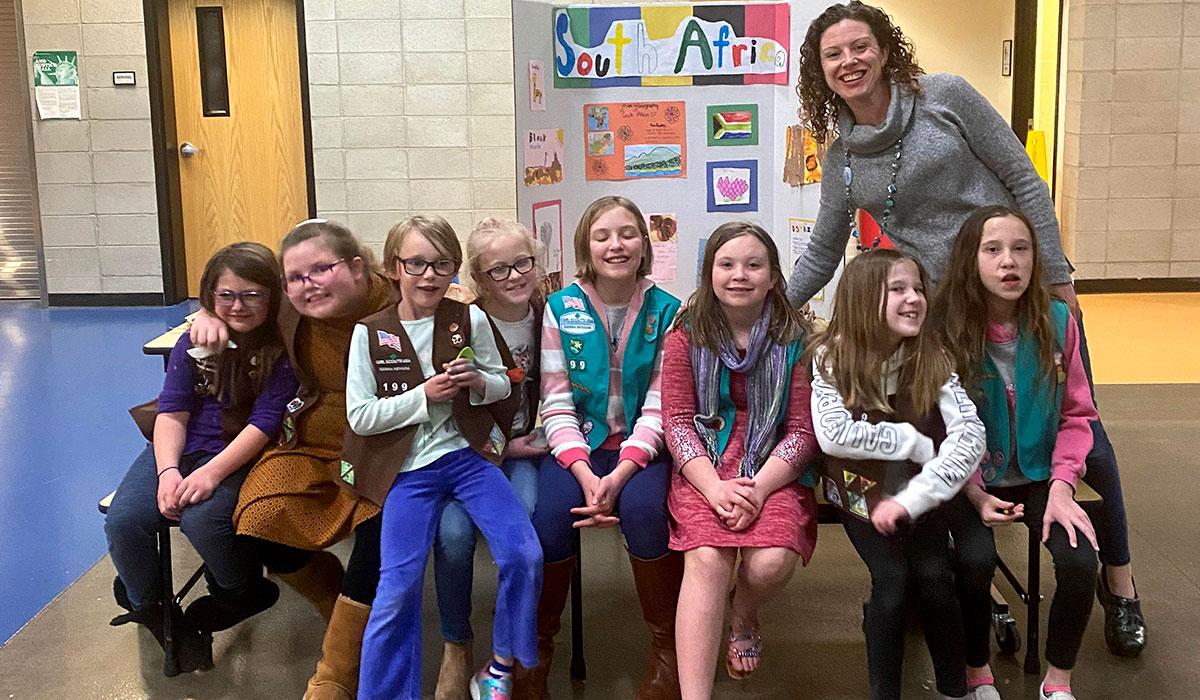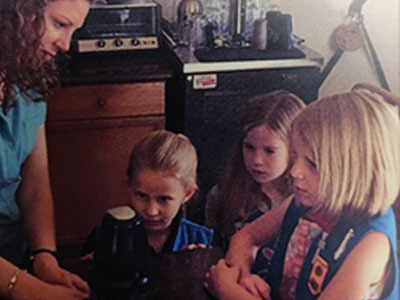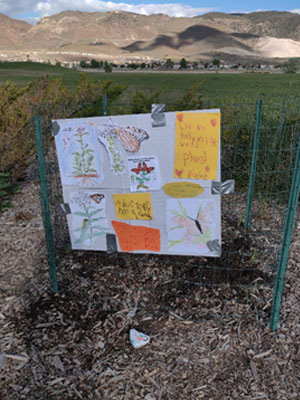
TMCC Biology Professor Amy Cavanaugh encourages her students to notice things-- to not only dive deep into the lifestyle of a college student but to consider how biology can prepare them for their futures. This may come from her background as an evolutionary biologist, a profession that enforces a specialized way of looking at the world. Evolution, after all, happens in the details. If you stand too far back, chances are, you’ll miss what’s happening right in front of you.
Cavanaugh teaches Anatomy and Physiology, and Molecular and Cellular Biology classes at TMCC’s William N. Pennington Health Science Center, where the lab limits each class size to 24 students. Because her classes are application requirements for many allied health programs like Nursing, she encounters many students who have made up their minds on a specific career path.
“I spend time with my students teaching them how to study and how to gain the confidence to feel like they can successfully complete these courses,” she said. “But the Biology department is really good about sending out possible research opportunities to students, which I like to forward on to them... [The pre-health track] is great... there are a lot of opportunities in those careers, but there is so much more that a student can do if they think about other possibilities.”
In this way, Cavanaugh encourages her students not to be afraid of exploring other options that could take them on an unexpected journey. After all, the discovery of new ideas is what led Cavanaugh to her career as a biologist and an educator.
Evolutionary Biology
As a high school student Cavanaugh was fascinated by the study of genetics, specifically Punnett Squares, which is a diagram in the shape of a square that is used to predict the resulting traits of cross-breeding experiments. For example, a Punnett Square could be used to predict the likelihood of a child being born with brown eyes if one parent has brown eyes, the other blue based on what we know about “meiosis”—the distribution of genetic inheritance. “It was just so amazing and you could predict how things would turn out. This was the late 90’s and there was this idea that gene therapy could cure cystic fibrosis in the next few years—which didn’t happen—but it seemed really exciting at the time,” she said.
Her excitement for science carried over into college when, in an Evolutionary Biology class, Cavanaugh was formally introduced to the theory of natural selection. “That [class] was the first time anyone had ever explained what the actual biological theory was behind natural selection to me. It was really so simple. The whole world made sense—and that’s when I dove in.”
While studying as an undergraduate at Drew University, she participated in an international seminar focused on the work of Darwin and his work on evolutionary theory. The class included a three-week trip to the Galapagos Islands to observe national selection “in action” and the research of contemporary scientists in the field. One example is the 30-year study of Galapagos finches by Peter and Rosemary Grant, which Cavanaugh studied as a part of the class.
“It was just so cool...they were documenting evolution happening in real-time from year to year, and showing how changes in this particular finch species—in the size and shape of their beaks—could mean the difference between life and death. Just a millimeter made a difference between these finches being able to get enough seeds to survive the season or not being able to. I think it was the first time I ever saw evolution as still happening and it happens right in front of our eyes and we can see it.” The experience would inspire Cavanaugh to later pursue a PhD. in Evolutionary Biology from the University of Louisville.
Watching life processes is something that Cavanaugh has brought to her life in the Truckee Meadows community and what she brings to the classroom. “I always knew I wanted to do a lot of teaching,” she said. “At some point, I did think I’d be doing more research, but as I moved through my graduate program, it became clear to me what I loved doing was teaching.”
Cavanaugh keeps an eye out for students who are curious about the material that is covered in her classes and who seem to be drawn to the study of biology for reasons beyond a defined career path. “Sometimes I literally walk up to them and say something like ‘you know, you’re made for this, I see a curiosity from you I appreciate.’ Or it’s usually the students who are asking you twenty semi-off topic questions, and I’ll invite them to talk to me during office hours.”
Last summer, one of Cavanaugh’s students was able to complete a research fellowship experience with the National Institute of Health (NIH) in Washington, D.C. “She was immersed in this really fascinating biomedical research. And I’m just so thrilled that I wrote one of her recommendation letters for the program. I was just so excited she got it, because she was one of those students—you could just tell. She has such an inquisitive mind.”
Encouraging students and giving them the knowledge itself, study skills, time management and that vital recommendation letter that students need to succeed is what makes teaching fulfilling for Cavanaugh.
Girl Scouts and Science
In addition to her duties as a tenured biology professor, Cavanaugh is also teaching science in another unexpected setting: to her troop of Girl Scouts. This role began two years ago, when her daughter showed an interest in joining the organization. Cavanaugh thought this might afford her an opportunity to fetch groceries and her kindergartener an opportunity to learn and grow with other girls her own age. “The Girl Scouts is an awesome organization and they really empower girls...I was like, yes let’s do it.”
However, Cavanaugh quickly became more involved with the Girl Scouts due to her daughter’s enthusiasm. “So I started staying, and of course, because I was there, I started helping out...and then I decided that if I’m going to be there and be involved, then let’s just formalize this.” As a troop leader for the “Daisies” (girls in kindergarten through the first grade) Cavanaugh shares her love of science through several hands-on activities that involve other TMCC faculty.
“Girl Scouts has this very girl-led philosophy... so even though you need to meet all these criteria for various badges, the girls decide what they are going to do to meet those criteria. It just so happens that my little group of girls are interested in all these sciency-things. So, I just started leveraging my biology department resources,” she said.

Professor Amy Cavanaugh leads her troop of Daisies through “journeys” on their way to learning skills and badges.
Girl Scout activities are organized into “journeys” that can lead to earning a badge. When Cavanaugh’s troop focused on a journey to protect a natural resource, Cavanaugh invited TMCC Biology Professor Meeghan Gray to attend a Girl Scout event. “She came with her tortoises, and that actually worked for several [age] groups of our scouts because they got to ask her all sorts of different questions about the tortoises, learn about their habitats and learn about protecting tortoises.”
The culmination of this journey asked the girls to come up with their own community project that would enable them to take action for some local natural resources. “It was really fun because it involved a lot of teaching them about plant life cycles and having them get outside every meeting and observe different things about the world around them,” said Cavanaugh, who—as she helped her troop to brainstorm different ideas—recalled that TMCC Biology Professor Megan Lhati was working on a milkweed project.

Cavanaugh’s troop along with TMCC Biology Professor Megan Lhati and TMCC student-interns planted milkweed to foster habitat for monarch butterflies in South Reno.
“It was phenomenal,” said Cavanaugh, who with the help of her colleague and several TMCC student-interns, created a hands-on lesson about monarch butterflies and the role that milkweed plays in their lifecycle. “We worked with the Parks Department to get permission to set up some plots in some of the local parks. Then, the girls planted milkweed and a year later, it’s still there and it’s thriving. And so, we made these little patches of monarch butterfly habitat and the girls are thrilled about it.”
In addition to providing the Girl Scouts with access to hands-on biology projects, the troop also provides these young girls with role models through their troop leaders and the other women who work in specific fields. “The three of us [troop leaders] are all working moms, which I think is awesome for the girls to see,” said Cavanaugh, who tries to bring as many opportunities to learn and explore to her troop as possible.
“The girls, they get to see that Eleanor’s mom is a scientist. And Ellie’s mom is a doctor. Alyssa’s mom works for the natural resources department. These are all the things that are possible for women to do. It is fun and extremely rewarding.”
The Value of Community College
Cavanaugh, who grew up on the east coast where “you can’t throw a rock without hitting a college” nonetheless has an appreciation for what community colleges like TMCC can offer to students, no matter what their age or degree program. “Our faculty have the same qualifications that they have at four-year schools. We’re just focused on teaching. That’s not to say that some faculty at research universities don’t love teaching—some of them do and take it very seriously. But, it’s not something that they are evaluated on. Instructors at TMCC are evaluated twice every semester to make sure [that they] are a quality instructor and that [they are] doing good work in the classroom.”
Cavanaugh also cites small class sizes as an advantage offered by community colleges like TMCC. “Small class size is so crucial. I have a maximum of 24 students in my classes—because we’re limited by lab space and stuff—so I get to know them, and I get to know what is going on in their lives. I get to truly work with them, and not just in a ‘look these are the requirements’ kind of way. And when things are going on in their lives—and so many things are going on in our students’ lives—my students feel like they can tell me those things because I share with them the human things that are happening in my life, and they feel as though they can, too. This enables us to work together. And that’s just what you get at a small community college. Here, it is truly all about the community.”
Cavanaugh also advocates for students in other capacities as well. She’s a part of a group of faculty working to get an “Anatomage Table” for students at the William N. Pennington Health Science Center. The table would serve several departments and programs; for Cavanaugh, it would offer students in her Anatomy and Physiology classes an incredible resource in the absence of cadavers. “It would allow students to do dissections—it’s virtual, of course—but it scans the cadaver at every level, so students can see every aspect of it. But, it also allows you to run physiological simulations, quiz students and run case studies.”
Working to improve student outcomes and access to education is key to Cavanaugh’s approach. In addition to teaching, she serves on the Salary/Budget and Benefits Committee, the Retirement Plan Advisory Committee and the Diversity Committee and is the past Chair of the Professional Standards Committee. To serve, she says, is the greatest honor.
“Institutional service is really important to me. My dad, who worked for a university, was one of those who would just do too many things. After retirement, he was still serving in a voluntary capacity on this giant task force to implement some big, new change. He always told me that to serve is the greatest honor—to be asked, to have someone trust you and believe that you can help is such an honor. So, I really like being able to serve on committees. I wish I had the time to do more of them.”
She sees this work as vital to her profession and in support of the college’s mission. Faculty are unique in that they are the only ones (besides students) to witness what happens in the classroom. Serving as a voice on committees enables Cavanaugh to advocate for positive change. “It’s important for academic faculty to take the time, to step up and be involved in making decisions to make sure the primary mission is always in the foreground. Plus, I’m isolated at Redfield, I wouldn’t really know anyone I work with if I didn’t serve on committees. It’s nice to find out what else is going on and get other perspectives from other faculty.”
Plus, it can be rewarding: sometimes, you can make a difference. Or sometimes, you discover that your committee chair always brings snacks. Whatever the reward, getting involved is key—because every journey, whether it’s for a student who’s seeking a fulfilling and successful career or for faculty seeking to further the institutional mission has to start by noticing the details of the environment around you. And sometimes, there are pleasant surprises in wait: a trip to the Galapagos, a new habitat for monarch butterflies or the opportunity to give back.
For more information about studying Biology at TMCC, contact the department at 775-673-8251.






